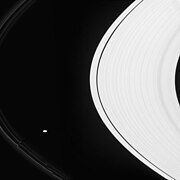Prometheus (moon)
Prometheus, as imaged by Voyager 2 on August 25, 1981 | |
| Discovery | |
|---|---|
| Discovered by | Collins, Voyager 1 |
| Discovery date | October, 1980 |
| Orbital characteristics[1] | |
| Epoch 31 December 2003 (JD 2453005.5 | |
| 139,380 ± 10 km | |
| Eccentricity | 0.0022 |
| 0.612990038 d | |
| Inclination | 0.008 ± 0.004° to Saturn's equator |
| Satellite of | Saturn |
| Physical characteristics | |
| Dimensions | 119×87×61 km [2] |
| 43.1 ± 2.0 km [2] | |
| ~23,000 km2 | |
| Volume | ~340,000 km3 |
| Mass | 1.566 ± 0.019 ×1017 kg [1] |
Mean density | 0.47 ± 0.07 g/cm3 |
| ~0.003 m/s2 | |
| ~0.019 km/s | |
| synchronous | |
| zero | |
| Albedo | 0.6 |
| Temperature | ~74 K |
Prometheus (Template:PronEng, Template:IPAlink-en,[3] or as in Greek Προμηθέας) is an inner satellite of Saturn. It was discovered in 1980 (some time before October 25) from photos taken by the Voyager 1 probe, and was provisionally designated S/1980 S 27.[4]
In late 1985 it was officially named after Prometheus, a Titan in Greek mythology.[5] It is also designated Saturn XVI.[6]
This small moon is extremely elongated, measuring about 119 by 87 by 61 km. It has several ridges and valleys and a number of impact craters of about 20 km diameter are visible, but it is less cratered than nearby Pandora, Epimetheus and Janus. From its very low density and relatively high albedo, it seems likely that Prometheus is a very porous icy body. There is a lot of uncertainty in these values, however, and so this remains to be confirmed.[citation needed]
Prometheus acts as a shepherd satellite for the inner edge of Saturn's F Ring. Recent images from the Cassini probe show that the Promethean gravitational field creates kinks and knots in the F Ring as the moon 'steals' material from it. The orbit of Prometheus appears to be chaotic, as a consequence of a mean motion resonance with Pandora. The most appreciable changes in their orbits occur approximately every 6.2 years,[1] when the periapsis of Pandora lines up with the apoapsis of Prometheus and the moons approach to within about 1400 km. Prometheus is itself a significant perturber of Atlas.
There is also an asteroid called 1809 Prometheus.
Image gallery
-
Time-lapse movie of Prometheus and the F Ring
-
Prometheus pulling material from the F Ring
-
Prometheus tugging kinks into the F Ring
References
- ^ a b c Spitale, J. N.; et al. (2006). "The orbits of Saturn's small satellites derived from combined historic and Cassini imaging observations". The Astronomical Journal. 132 (2): 692–710. doi:10.1086/505206.
{{cite journal}}: Explicit use of et al. in:|author=(help) - ^ a b Porco, C. C.; et al. (2006). "Physical Characteristics and Possible Accretionary Origins for Saturn's Small Satellites" (PDF). Bulletin of the American Astronomical Society. 37: 768.
{{cite journal}}: Explicit use of et al. in:|author=(help) - ^ In US dictionary transcription, Template:USdict.
- ^ IAUC 3532: Satellites of Saturn 1980 October 31 (discovery)
- ^ IAUC 4157: Satellites of Saturn and Pluto 1986 January 3 (naming the moon)
- ^ "Planet and Satellite Names and Discoverers". Gazetteer of Planetary Nomenclature. USGS Astrogeology. July 21, 2006. Retrieved 2006-08-07.
External links
- Prometheus collides with the F Ring, pulls away a streamer, and creates another channel
- Prometheus Profile by NASA's Solar System Exploration
- The Planetary Society: Prometheus


